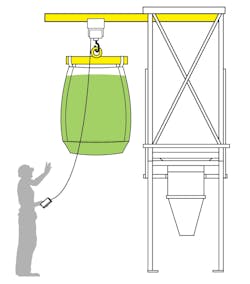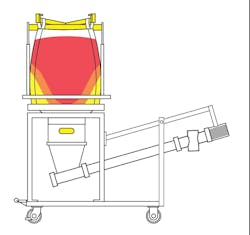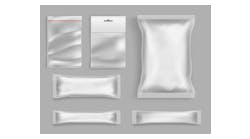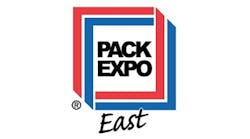Choosing the right bulk bag unloader is essential to your production process, whether you are upgrading an existing system or entering the market for the first time. Not all bulk bag dischargers are created equal, and many different factors need to be considered to find the right fit for your application. There is a range of bulk bag unloading options on the market, many of which can be customized to fit your specific needs. From choosing the right dust seal design to assessing the weight of filled bags, it is important to take a comprehensive approach to ensure safe and efficient operation.
The following engineering tips can help you select the right bulk bag unloader for your application.
Define your bulk bag unloading requirements
The first thing to consider is the type of material being handled and whether it requires special containment to prevent potential harm to operators or the environment. In these cases, seals between the bag and the discharger are necessary to prevent dust from escaping. Depending on the discharger's design, various dust seal configurations are available, such as a rubber membrane or a peripheral double dust seal.
It is also crucial to evaluate the material's flow characteristics. For instance, if the material has poor flowability, flow aids such as massage paddles, agitators, vibrators or air pads could be employed. Additionally, if the material agglomerates, a bulk bag conditioner may be necessary to break up the material and reduce lumps.
If the material is combustible or will be operated in an explosion-rated environment, the discharger will need features to protect the equipment and operators. These features may include explosion-proof motors and static grounding and monitoring systems.
Know your bag specifications
When selecting a bulk bag unloader, it is essential to consider all of the specifications of the bags that will be handled.
The first specifications to evaluate are the bag dimensions. Typically, the base dimensions range from 35 inches square to 41 inches square. Any dimensions outside this range may require a larger frame and bag support dish. The range of side seam heights is also crucial, as this determines the size of the discharger structure and any necessary space-saving options that may need to be considered.
Another crucial specification is the base construction of the bags. If the bag has an outlet spout, it is essential to know the spout diameter and length to ensure the correct operation of features such as spout closure bars and hygienic connections. On the other hand, flat-bottom bags require a purpose-built knife to cut the base as the bag is lowered into the discharger. Conical bottom bags can typically be used with a standard discharger as long as the ties securing the cone can be safely released.
It is also important to consider the style of lifting loops, with the two main styles being lay flat and cross corner. Confirming compatibility with standard bag lifting frames is necessary for a safe, secure and reliable fit.
Assess your bulk bag handling requirements
The next important step is to assess the preferred method of bulk bag handling. This involves considering several factors, including the method of loading bags into the unloader and the weight of filled bags.
Determining the loading method will help identify the discharger frame type required. Additionally, assessing the filled bag weight is essential to ensure that the discharger frame can safely handle the maximum weight. It will also determine the necessary hoist and trolley capacity for a monorail-style discharger.
It is important to remember that handling heavy bags can pose safety risks to operators. Therefore, for heavier bulk bags, choosing a bulk bag unloader with a design that minimizes manual handling is vital to ensure safe and efficient operation.
Determine the method of downstream material transfer
A bulk bag discharger can drop materials directly into another vessel or piece of downstream process equipment, or this can be achieved by way of an intermediate conveying system for transfer downstream to the next processing step. Choosing the right option depends largely on the location and layout of the entire process and is often impacted by the available headroom.
Factors to consider include the distance between process steps and the height requirements of the downstream process equipment material inlet points. In addition, the material's flow characteristics and whether the material is free flowing or sticky will determine the type of conveyor that should be selected and any flow aids that may be required to ensure that the material can freely enter the conveyor.
Define weight batching or dosing requirements
The requirements for weight batching and dosing are essential for accurate and efficient material handling.
The two standard techniques for weight metering are loss-in-weight (LIW) and gain-in-weight (GIW). In LIW metering, the bulk bag, along with some parts of the discharger and the metering or feeding device are weighed, and the control system monitors the system's weight loss as the material is fed into the next stage of the process. Conversely, GIW metering involves placing the receiving container on load cells and monitoring the gain in weight of the vessel before feeding.
The choice of batching method depends on the specific requirements of the application. Some factors include the size, rate and accuracy requirements of batches, the type and number of materials being handled, and sanitation/cleanout requirements.
Consider customizable bulk bag unloader options
Many suppliers offer a range of customization options to meet specific process needs and performance requirements. These customizable options can ensure reliable, safe and hygienic operation to maximize efficiency and minimize the risk of health hazards. Consider the following options:
Mobility. When manufacturers need to relocate their dischargers to different areas within their plant, a mobile option can be added to the equipment. This feature allows the unloader to be securely locked in place while in use and then quickly wheeled to another location to feed a different process.
Integral bag dump station. If small (typically 50-pound) bags also need to be emptied into a bulk bag discharger, a second bag dump enclosure with a safety grid can be incorporated under the standard untie chamber, or an oversized untie chamber incorporating these features can be added.
Clean-in-place features. The equipment's cleaning requirements should be considered when deciding on design options, such as spray balls, drain ports, different surface finishes, frame design, and materials of construction. These elements can be individually specified to meet a range of hygienic requirements.
Dish hopper cover. To prevent foreign materials from contaminating the internal parts of the discharger that come into contact with the material during the bag unloading process, a pneumatically operated cover can be added to the discharger dish or hopper-inlet.
Safety. Operator safety is always a primary concern, and the design must allow operators to quickly and safely untie or retie bags with outlet spouts. The discharger should also include a device that closes off the outlet spout, enabling a partially emptied bag to be safely removed.
Residual dust in empty bags. Depending on the material being handled, you may need to be able to evacuate the dust-laden air that remains in the empty bulk bag before it is removed from the discharger. Dust-free bag compacting and sealing stations can also be added as required.
Test the selected design
Before implementing the selected design, it is highly recommended that you test the equipment in the supplier’s test laboratory. This allows for the analysis of specific characteristics and ensures that the design is suitable for the particular process needs, reducing the potential for production challenges later.
Testing the equipment before implementation allows you to identify and make any necessary modifications or adjustments to ensure optimal performance and efficiency. Additionally, working with a reputable supplier that offers testing facilities can provide peace of mind and confidence in the equipment's performance and longevity.
Working with an experienced supplier to incorporate the most appropriate performance, hygiene and safety features will help you safeguard against health risks, streamline production, and ensure that your bulk bag unloading process meets or exceeds all of your requirements and expectations.
Andy Forrester is vice president of sales for the Americas at Spiroflow Systems and a former Royal Air Force officer. He has more than 20 years of experience in senior-level roles across the powder and bulk solids, manufacturing and construction industries. He can be reached at [email protected].
Spiroflow





